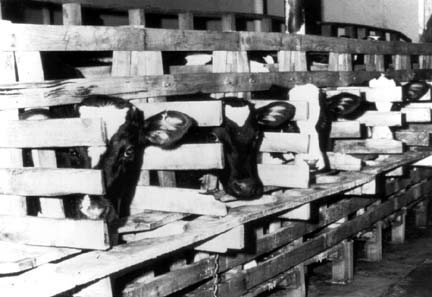
BUCKING THE MYTH: THE CRUEL REALITY OF RODEOS
Many people believe that rodeos provide harmless entertainment, but The HSUS, after many years of investigating this so-called sport, knows that what takes place at rodeos is just another form of cruelty. Contrary to the myth perpetuated by the rodeo industry, rodeos do not educate people about ranching skills important in the Old West. In fact, rodeo events have been created specifically for public entertainment. And the animals used in rodeos do not live on ranches, cared for by the contestants. They are animals who have been rented from stock contractors. Far removed from the range, these animals spend most of their lives in cramped quarters and transportation vehicles and do not always receive proper medical care. Indifference to the welfare of these animals is built into the system of rodeo judging: a contestant's score is based on how long he/she can ride an unwilling animal or how quickly he/she can overpower an animal (the force of whose resistance actually adds to the contestant's score). Rodeo contestants are rarely penalized for injuring or killing an animal.
Events differ from rodeo to rodeo, but the most common rodeo events are bronc riding, bull riding, calf roping, and steer wrestling.



HUMANE SLAUGHTER JEOPARDIZED UNDER NEW USDA PLAN
The meatpacking industry, a business driven by profits, already has a reputation for poor treatment of both animals and workers. Now, the USDA's Food Safety Inspection Service (FSIS) has proposed that certain slaughter facilities take on inspection responsibilities rather than have FSIS actually conduct inspections. Plants that slaughter market pigs, fed cattle, and young poultry (classes that comprise some 90% of all animals slaughtered in inspected plants) would be in control of their own inspections. USDA's own surveys show that the Humane Slaughter Act is already routinely violated and underenforced and this plan affords workers no whistleblower protections from industry retaliation.
WHAT YOU CAN DO: Write comments to USDA and tell them: 1) USDA is legally charged with ensuring the humane slaughter of animals and with inspecting each individual animal prior to and after slaughter, 2) you object to relaxing the process that exists to protect both animals and consumers, and don't trust the meat industry to regulate itself. Send comments ASAP to: FSIS Docket Clerk, Docket #98-039N, Room 102, Cotton Annex Building, 300 12th Street, S.W., Washington, DC, 20250-3700.


STAMP OUT OVERPOPULATION
The Prevent a Litter Coalition (PaLC) has been pushing the U.S. Postal Service to create a postal stamp depicting companion animals and bearing the message "Spay/Neuter--Save a Life" and they seem to have made some serious headway! The U.S. Postal Service Citizens' Stamp Advisory Committee (CSAC) will be considering this idea in the October 1998 meeting and NEED TO HEAR FROM YOU! E-mail PaLC at pawunit@aol.com for more info.
WHAT YOU CAN DO: Please write to the Postal Service favoring the creation of a spay/neuter stamp. Letters go to: Dr. Virginia Noelke, Chair, Citizens' Stamp Advisory Committee, United States Postal Service, 475 L'Enfant Plaza, S.W., Rm. 4474E, Washington, DC 20260-2437.

Write or Call Today!
In an effort to re-define the world's cruelest, most outdated, and inhumane trap as "humane," the U.S. Congress is considering legislation that contains nearly $500,000 for trap testing. The bulk of the money will be for continued testing of the infamous steel jaw leghold trap. Leghold traps are notorious for the pain and prolonged suffering that they inflict. Designed to capture animals by their limbs, the animal victims often chew and amputate their own legs in an effort to escape.
Countless leghold trap tests have been conducted over recent decades. These tests have created an extensive body of knowledge attesting to the trauma inflicted on target and non-target animals. Further, there is widespread opposition to these cruel and indiscriminate devices. At this time, 88 countries have prohibited use of leghold traps, and an increasing number of U.S. states and municipalities have outlawed or severely restricted their use. Arizona, Colorado, and Massachusetts have recently approved statewide ballot initiatives against leghold traps.
WHAT YOU CAN DO: Members of the House and Senate Conference Committee on H.R. 4101 and S. 2159, FY 1999 Agriculture Appropriations, are working out the details of the legislation. Please contact your representative and senators and let them know that you oppose continued tax dollars for wasteful trap testing. No funds should be expended to further test the barbaric and antiquated leghold type trap.
Please send an urgent message to your representative and senators via letter, phone call, fax or e-mail.
Address correspondence with House members to: The Honorable (name here) U.S. House of Representatives Washington, D.C. 20515
Address correspondence with senators to: The Honorable (name here) U.S. Senate Washington, D.C. 20510
Capitol switchboard: (202) 225-3121
Use our Make Contact search page to find out the names and e-mail addresses of your representative and senators.
Please send us copies of any replies you receive.
Please send an urgent message to your representative and senators via letter, phone call, fax or e-mail.
Address correspondence with House members to: The Honorable (name here) U.S. House of Representatives Washington, D.C. 20515
Address correspondence with senators to: The Honorable (name here) U.S. Senate Washington, D.C. 20510 Capitol switchboard: (202) 225-3121
Use our Make Contact search page to find out the names and e-mail addresses of your representative and senators. Please send us copies of any replies you receive.
Continued leghold trap testing is wasteful and duplicative.
Leghold traps are notorious for the pain and suffering that they
inflict.
No tax dollars should be spent to disguise the inherently
hideous nature of leghold traps.
For more information on this or any other animal protection issue,
contact the HSUS Government Affairs department at (202)
452-1100.




